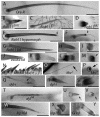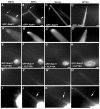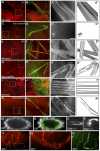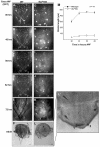Dusky-like functions as a Rab11 effector for the deposition of cuticle during Drosophila bristle development
- PMID: 22278919
- PMCID: PMC3274354
- DOI: 10.1242/dev.074252
Dusky-like functions as a Rab11 effector for the deposition of cuticle during Drosophila bristle development
Abstract
The morphogenesis of Drosophila sensory bristles is dependent on the function of their actin and microtubule cytoskeleton. Actin filaments are important for bristle shape and elongation, while microtubules are thought to mediate protein and membrane trafficking to promote growth. We have identified an essential role for the bristle cuticle in the maintenance of bristle structure and shape at late stages of bristle development. We show that the small GTPase Rab11 mediates the organized deposition of chitin, a major cuticle component in bristles, and disrupting Rab11 function leads to phenotypes that result from bristle collapse rather than a failure to elongate. We further establish that Rab11 is required for the plasma membrane localization of the ZP domain-containing Dusky-like (Dyl) protein and that Dyl is also required for cuticle formation in bristles. Our data argue that Dyl functions as a Rab11 effector for mediating the attachment of the bristle cell membrane to chitin to establish a stable cuticle. Our studies also implicate the exocyst as a Rab11 effector in this process and that Rab11 trafficking along the bristle shaft is mediated by microtubules.
Figures







Similar articles
-
dusky-like is required to maintain the integrity and planar cell polarity of hairs during the development of the Drosophila wing.Dev Biol. 2013 Jul 1;379(1):76-91. doi: 10.1016/j.ydbio.2013.04.012. Epub 2013 Apr 23. Dev Biol. 2013. PMID: 23623898 Free PMC article.
-
Bchs, a BEACH domain protein, antagonizes Rab11 in synapse morphogenesis and other developmental events.Development. 2006 Dec;133(23):4655-65. doi: 10.1242/dev.02650. Epub 2006 Nov 1. Development. 2006. PMID: 17079274
-
Actin filaments and microtubules play different roles during bristle elongation in Drosophila.J Cell Sci. 2000 Apr;113 ( Pt 7):1255-65. doi: 10.1242/jcs.113.7.1255. J Cell Sci. 2000. PMID: 10704376
-
Morphogenesis of Drosophila melanogaster macrochaetes: cell fate determination for bristle organ.J Stem Cells. 2012;7(1):19-41. J Stem Cells. 2012. PMID: 23550342 Review.
-
The dynamic Rab11-FIPs.Biochem Soc Trans. 2009 Oct;37(Pt 5):1032-6. doi: 10.1042/BST0371032. Biochem Soc Trans. 2009. PMID: 19754446 Review.
Cited by
-
The Gene Expression Program for the Formation of Wing Cuticle in Drosophila.PLoS Genet. 2016 May 27;12(5):e1006100. doi: 10.1371/journal.pgen.1006100. eCollection 2016 May. PLoS Genet. 2016. PMID: 27232182 Free PMC article.
-
Dusky-like is required for epidermal pigmentation and metamorphosis in Tribolium castaneum.Sci Rep. 2016 Feb 1;6:20102. doi: 10.1038/srep20102. Sci Rep. 2016. PMID: 26829909 Free PMC article.
-
dusky-like is required to maintain the integrity and planar cell polarity of hairs during the development of the Drosophila wing.Dev Biol. 2013 Jul 1;379(1):76-91. doi: 10.1016/j.ydbio.2013.04.012. Epub 2013 Apr 23. Dev Biol. 2013. PMID: 23623898 Free PMC article.
-
The Drosophila planar polarity gene multiple wing hairs directly regulates the actin cytoskeleton.Development. 2015 Jul 15;142(14):2478-86. doi: 10.1242/dev.122119. Epub 2015 Jul 7. Development. 2015. PMID: 26153232 Free PMC article.
-
The frizzled/stan pathway and planar cell polarity in the Drosophila wing.Curr Top Dev Biol. 2012;101:1-31. doi: 10.1016/B978-0-12-394592-1.00001-6. Curr Top Dev Biol. 2012. PMID: 23140623 Free PMC article. Review.
References
-
- Abdu U., Bar D., Schupbach T. S. (2006). spn-F encodes a novel protein that affects oocyte patterning and bristle morphology in Drosophila. Development 133, 1477–1484 - PubMed
-
- Band A. M., Ali H., Vartiainen M. K., Welti S., Lappalainen P., Olkkonen V. M., Kuismanen E. (2002). Endogenous plasma membrane t-SNARE syntaxin 4 is present in rab11 positive endosomal membranes and associates with cortical actin cytoskeleton. FEBS Lett. 531, 513–519 - PubMed
-
- Bogard N., Lan L., Xu J., Cohen R. S. (2007). Rab11 maintains connections between germline stem cells and niche cells in the Drosophila ovary. Development 134, 3413–3418 - PubMed
Publication types
MeSH terms
Substances
Grants and funding
LinkOut - more resources
Full Text Sources
Molecular Biology Databases

